Time-Resolved Absorption Spectroscopy Educational Kit
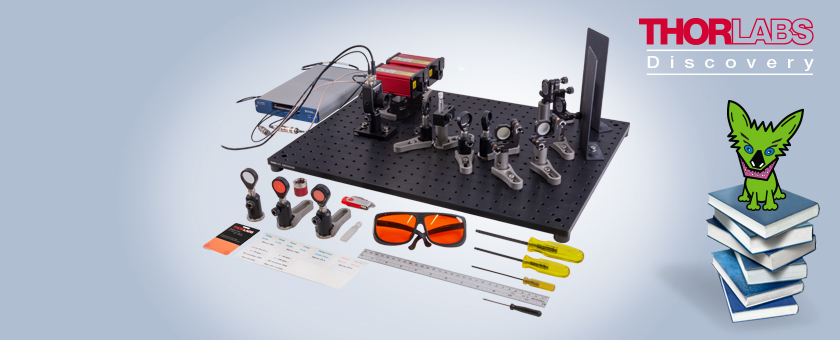
- Designed for Education, Demonstration, and Classroom Use
- Easy-to-Use Kits Include Components Plus Free Educational Materials

Please Wait
Time-Resolved Absorption Spectroscopy Kit
- Designed for Educational, Demonstration, and Classroom Use
- Complete Photonics Kit Includes All Hardware, Tools, and Software (Computer and Samples Not Included)
- Includes Extensive Manual for Easy Assembly and Use
- Choose from Educational Kits Containing Imperial or Metric Components
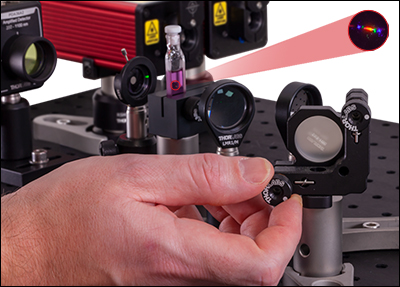
Click to Enlarge
Figure 1.1 Adjusting the overlap of the pump and probe beams optimizes the transient absorption signal produced by 0.8 mMol/L ZnTPP in benzonitrile solution. The zoomed-in view shows the pump and probe beams aligned on the sample cuvette. Note: the probe laser (blue) is not visible with the standard setting of 2 kHz nor with the laser safety glasses. The laser repetition rate was changed for clear visualization of the beams.
Time-Resolved Absorption Spectroscopy Kit Details
- Build a Transmission-Based Setup for Nanosecond Time-Resolved Absorption Spectroscopy
- Explore the Effect of the Pump Beam Focusing Lens on the Transient Absorption Signal
- Determine the Decay Time of an Excited State Population
- Investigate the Influence of Concentration and the Presence of Additional Species on the Decay Time
- Optional Experiments for Exploring Data Deconvolution, Laser Pulse Width Influence on Transient Absorption Signal, and Beam Focus Optimization
- Samples Available Separately (See EDU-TRASK Sample Kit Sold Below)
Thorlabs' EDU-TRAS1(/M) Time-Resolved Absorption Spectroscopy (TRAS) Educational Kit explores depopulation and charge transfer dynamics in the nanosecond regime using transient absorption (TA) spectroscopy. This technique uses transmission measurements to determine the change in absorbance of a sample after excitation by light. Designed for a master's level laboratory course, this kit builds the foundation to understand more complex femtosecond spectroscopy techniques commonly used in research. All mechanical and optical components, as well as the required light sources, needed to build a TRAS setup in the lab are included.
This kit measures the TA signal in zinc-tetraphenylporphyrin (ZnTPP), which is a molecule often used in light harvesting applications, to study excited state population dynamics. Also investigated is the influence of fullerene C70 on the depopulation speed, or decay time. In addition to performing the experiments supported by the kit, students also have the opportunity to practice standard optical alignment techniques and explore how misalignments in an optical setup can affect the detected TA signal.
The standard experiments in this kit require six different samples, including three concentrations of ZnTPP in benzonitrile (0.8, 0.4, and 0.2 mMol/L) and three mixing ratios of ZnTPP to C70 (1:0.1, 1:0.5, and 1:1). Samples can be prepared using raw chemicals by following the detailed instructions included in the manual. An overview video of this sample preparation procedure can be found on the Samples tab. Alternatively, the EDU-TRASK Sample Kit is available for purchase in select countries. This kit includes 4 mL of each required sample concentration and disposable pipettes. Additional experiments using a water-soluble Ruthenium complex are described in the manual.
Thorlabs Educational Products
Thorlabs' line of educational products aims to promote physics, optics, and photonics by covering many classic experiments, as well as emerging fields of research. Each educational kit includes a manual that contains both detailed setup instructions and extensive teaching materials. These lab kits are being offered at the price of the included components, with the educational materials offered for free. Technical support from our educational team is available both before and after purchase.
Purchasing Note: Both English and German language manuals are available for our educational kits. The imperial educational kit contains the English manual and US-style power cords. The appropriate manual and power cords will be included in the metric kit based on your shipping location. The power supplies and other electronic devices in both the metric and the imperial kit accept voltages of 230 VAC and 120 VAC. Please contact Tech Support if you would like the German manual included with the imperial version of the kit. As with all products on our website, taxes are not included in the price shown below.
Laser Safety
Thorlabs' Time-Resolved Absorption Spectroscopy Kit uses two Class 3B lasers, the NPL45B and NPL52C nanosecond pulsed lasers, which requires that all users be trained and follow all necessary safety protocols. This includes wearing the LG3 laser safety glasses shipped with the kit. More details about the laser classification system and Thorlabs laser safety products can be found on the Laser Safety tab.
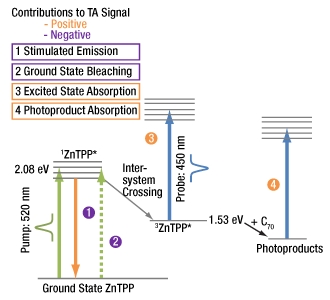
Click to Enlarge
Figure 2.1 A simplified energy-level diagram of ZnTPP and C70. Only the energy levels contributing to the transient absorption are shown.
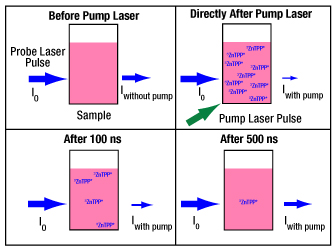
Click for Details
Figure 2.2 The 3ZnTPP* excited state concentration and probe beam intensity (blue arrow) with increasing delay time. The size of the arrow shows the relative intensity of the pulse.
The EDU-TRAS1(/M) kit investigates depopulation and charge transfer dynamics using time-resolved absorption spectroscopy (TRAS), which is a type of pump-probe spectroscopy. This type of spectroscopy uses two laser beams with short pulse lengths; one pulsed beam (the pump) excites the sample while a second pulsed beam (the probe) monitors the pump-induced changes in the absorption via a transmission measurement. By changing the time delay between the two pulses, absorbance changes on time scales of a few femtoseconds to hundreds of microseconds can be followed. This signal, called the transient absorption (TA), can then be used to evaluate reaction models. Below is a brief overview of the theoretical models used in this kit; see the EDU-TRAS1 manual for more details.
Transient Absorption (TA) via Transmission
Transient absorption (TA) is the difference in absorbance ΔA between two states of a system: the absorbance of the probe laser by the sample directly following a pump laser pulse and the absorbance of the probe laser without a pump laser pulse. A TA curve is formed by measuring the ΔA signal for varying delay times τ between the pump and probe laser pulses.
To calculate the TA signal, this kit uses a transmission measurement. Since the absorbance of light in a solution follows the Lambert-Beer's law and the probe laser in this kit has a fixed wavelength, the TA signal can be described as:

where Iwith pump and Iwithout pump are the intensities of the probe beam light passing through the sample with and without exciting the sample with a pump pulse, respectively. The TA signal can be negative or positive depending on the contributing processes.
Excitation Pathways in ZnTPP
The TA signal has several contributing processes, including stimulated emission, ground state bleaching, excited state absorption (ESA), and photoproduct absorption (PA). The strength of each process is dependent on the probe-laser wavelength. To ensure a large net positive TA signal, this kit uses a 450 nm probe laser and zinc-tetraphenylporphyrin (ZnTPP), which is a well-characterized molecule that is often used in applications such as artificial photosynthesis, solar cells, and organic-based photovoltaic devices. In this kit, the dominating processes are ESA and PA, which are defined as:
- ESA: Excited electrons can be excited into higher states by absorption of the probe beam.
- PA: Excited molecules can react and form a new photoproduct, and the probe beam is absorbed by the new photoproduct.
As shown by the solid green arrow in Figure 2.1, ground state ZnTPP is excited to the 1ZnTPP* singlet state by the pump beam, which has a 520 nm emission wavelength. However, this singlet state is short-lived, and almost immediately decays to the 3ZnTPP* triplet state; this is indicated by the gray diagonal arrow. The longer-lived 3ZnTPP* excited state strongly absorbs the 450 nm probe laser wavelength, as shown by the solid blue arrow; this is the ESA contribution to the TA signal.
In this kit, the absorbance change is determined by measuring the intensity of the probe beam with a photodetector after it passes through the sample. See Figure 2.2 for a visualization of how the concentration and absorption change with increasing delay time. By repeating TA measurements for varying time delays between the pump and probe pulses, a full time-resolved absorption decay curve can be generated.
Also studied in this kit is how an additional chemical species affects the 3ZnTPP* depopulation rate. By adding fullerene C70 to the ZnTPP sample, the 3ZnTPP* excited state is also depopulated by an electron transfer process that occurs between the two molecules, which reduces the decay time. This additional depopulation pathway is the PA contribution to the TA signal, represented in the energy-level diagram as the diagonal black arrow.
Thorlabs' EDU-TRAS1(/M) Time-Resolved Absorption Spectroscopy (TRAS) kit investigates the transient absorption signal in the zinc-tetraphenylporphyrin (ZnTPP) molecule. Understanding the population dynamics of this molecule is of interest for applications such as light harvesting, which aims to improve the efficiency of solar energy conversion. This kit includes all the optical and mechanical components needed for a time-resolved absorption spectroscopy setup, and software for controlling the acquisition parameters is also provided (see the Software tab for more information). Metric and imperial versions of this kit are available.
The manual accompanying this kit contains theoretical background material for introducing students to transient absorption (TA) measurements. This includes describing light absorption with Lambert-Beer's law, the generation and deactivation pathways of ZnTPP, time and concentration-dependent reaction rates, and the reaction pathways created by introducing an electron acceptor. The manual also provides detailed setup instructions and a series of experiments, which are detailed below.
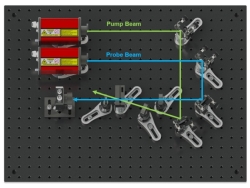
Click to Enlarge
Figure 3.1 An overhead view of the final EDU-TRAS1 setup, excluding the DAQ card. The pump and probe beam paths are shown by green and blue lines, respectively.
Aligning the Setup
A main objective of the EDU-TRAS1 kit is to provide students with an opportunity to practice optical alignment techniques. The highest TA signals are observed when tightly focused beams have a large overlapping region, making a well-aligned setup essential for measurements.
This kit provides all the equipment needed to build up a TRAS experiment, and a full list of the included components can be found on the Kit Components tab. The manual walks students through the assembly of each component, as well as the alignment procedure for both the probe and pump laser beam paths.
In this kit, the pump and probe laser pulses are electronically generated by the NPL52C and NPL45B nanosecond pulsed lasers, respectively. These lasers both have adjustable pulse lengths and trigger inputs. Each beam is focused by a single lens; kinematic mirrors are used to overlap the beams inside the sample volume. After passing through the sample, the probe laser is detected by the PDA36A2 photodetector. A bandpass filter is used to block ambient and pump laser light from reaching the detector. Also included is a digital acquisition card (DAQ) by National Instruments, which is used to sample the photodiode voltage signal and to implement the pump-probe delay time set in the software. An image of the fully assembled setup (excluding the DAQ Card) with the pump (green) and probe (blue) beam paths included is shown in Figure 3.1.
The highest TA signals are measured when the pump and probe beams have a large overlap region and small beam waists. To maximize the resulting TA signal, a beam walk is used to overlap the two beams. Students are encouraged to examine how the TA signal is affected by the quality of the beam overlap. Video 3.2 shows the procedure for optimizing the beam overlap to maximize the transient absorption signal. To explore the importance of the beam waist size on the TA signal, this experiment also has students optimize the system alignment for two different pump beam focusing lenses (f = 60 mm and f = 75 mm). Students are encouraged to compare the signal strength resulting from each lens.
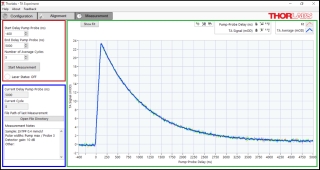
Click to Enlarge
Figure 3.3 An example TA decay curve for the 0.8 mMol/L ZnTPP in benzonitrile base solution.
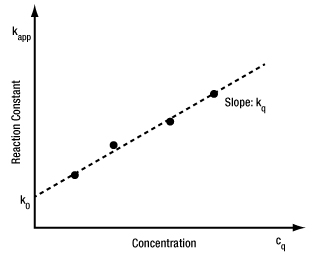
Click to Enlarge
Figure 3.4 The reaction constant kq can be determined by measuring the decay time for several concentrations of ZnTPP to C70 and applying a linear fit.
Measuring the Decay Time of the ZnTPP Excited State
Students determine the decay time of the 3ZnTPP* excited state by measuring the TA decay curve for the 0.8 mMol/L ZnTPP in benzonitrile (BN) solution. To create this curve, the software generates a single data point for each time delay within the defined pump-probe delay range, and measurements are made in increments of 10 ns. The TA signal value for each data point is calculated using the transient absorption (ΔA) equation shown on the Kit Basics tab, where Iwith pump and Iwithout pump are average values measured during the 40 ms acquisition period. As shown in the example trace (see Figure 3.3), we recommend a time delay range of -400 ns to 5000 ns for the ZnTPP samples in this kit.
The TA decay curves measured in these experiments typically contain a significant amount of noise. To improve the signal-to-noise ratio of the measurement, several traces should be recorded and averaged, and this can be set in the software using the number of average cycles input parameter. In the Figure 3.3 example, five traces were recorded and then averaged. The individual and average traces appear as thin multi-colored lines and a thick blue line, respectively.
Since the 3ZnTPP* excited state population is expected to decay exponentially as the time delay τ between the excitation pulse and the probe pulse increases, it can be described by a function of the following form:

where CT(t) is the concentration of the excited 3ZnTPP* triplet state at a given time t, CT(0) is the maximum TA signal, and ko is the reaction constant. The excited triplet state depopulates with a decay time of T = 1/ko.
Effect of Concentration on ZnTPP Absorption
In this experiment, students measure the time-resolved absorption curve for several different concentrations of ZnTPP solution to see how the increased number of molecules influences the decay time, as well as the maximum TA signal. Information on the recommended sample concentrations can be found on the Samples tab.
Charge Transfer Between ZnTPP and C70
In this experiment, students investigate how a quenching partner affects the 3ZnTPP* depopulation rate. In the presence of a new species, the first-order integrated rate law describing the 3ZnTPP* excited state decay can be written as:

where CT(t) is the concentration of the excited 3ZnTPP* triplet state at a given time t, ko is the reaction constant of 3ZnTPP* deactivation, Cq is the concentration of the quenching partner, and kq is the reaction constant of the quenching partner. Summarizing the constants into a single term kapp = ko + kq · Cq, called the apparent reaction constant, the resulting solution is:

where CT(0) is the maximum TA signal, and kapp is the apparent reaction constant. The TA decay curve for a mixed-species solution describes an excited triplet state with a decay time of Tapp = 1/kapp.
For this kit, the quenching partner used is fullerene C70. The new deactivation channel introduced is an electron transfer process that occurs between the C70 and 3ZnTPP*. By measuring the TA curve for solutions with varying ZnTPP to C70 ratios (see Samples tab), students observe the influence of the C70 concentration on the maximum TA signal and the decay time. As shown in Figure 3.4, students are also able to determine the reaction constant kq of the quenching reaction by plotting the apparent reaction constant kapp against the mixing ratio and applying a linear fit. This value describes the quenching efficiency of the C70 and can be compared to values published in literature.
Ideas for Additional Experiments
The following topics, which are outside the scope of this kit, can also be explored:
- Convolution and Deconvolution of Data to Understand the Instrument Response Function
- The Influence of the Pump Laser Pulse Width on the TA Signal
- Beam Focus Optimization
- Alternative Sample System Based on Water-Soluble Ruthenium Complexes
These exercises are detailed in the manual and may require additional equipment or software not supplied with the kit.

Thorlabs' Time-Resolved Absorption Spectroscopy Kit is available in imperial and metric versions. In cases where the metric and imperial kits contain parts with different item numbers, metric part numbers and measurements are indicated by parentheses unless otherwise noted.
| Item # | Description | Qty. |
|---|---|---|
| Breadboard | ||
| MB1824 (MB4560/M) | Aluminum Breadboard, 18" x 24" x 1/2" (45 cm x 60 cm x 1.27 cm) |
1 |
| RDF1 | Rubber Damping Feet, Set of 4 | 2 |
| Light Sources | ||
| NPL45B | Nanosecond Pulsed Laser Diode System, 450 nm, 5 - 39 ns Adjustable Pulse Width | 1 |
| NPL52C | Nanosecond Pulsed Laser Diode System, 520 nm, 6 - 129 ns Adjustable Pulse Width | 1 |
| Optics | ||
| BB1-E02 | Ø1" Broadband Dielectric Mirror, 400 - 750 nm | 4 |
| LA1134-A | N-BK7 Plano-Convex Lens, Ø1", f = 60 mm, Anti-Reflection Coated |
1 |
| LA1608-A | N-BK7 Plano-Convex Lens, Ø1", f = 75 mm, Anti-Reflection Coated |
1 |
| LA1509-A | N-BK7 Plano-Convex Lens, Ø1", f = 100 mm, Anti-Reflection Coated |
1 |
| FESH0500 | Ø25 mm Shortpass Filter, 500 nm Cutoff Wavelength | 1 |
| -a | Post-Mountable Iris, Ø15.0 mm Max Aperture, 8-32 (M4) Threaded Stud | 1 |
| Mounting | ||
| KM100 | Ø1" Kinematic Mirror Mount | 4 |
| RS2P8E (RS2P4M) | Ø1" (Ø25.0 mm) Pedestal Post, 2" (50 mm) Long | 5 |
| RSH1.5 (RSH1.5/M) | Ø1" (Ø25.0 mm) Post Holder, 1.5" (38 mm) Long | 2 |
| CF125 | Clamping Fork | 10 |
| PF85B | Clamping Fork for Ø1.5" Post Holders | 2 |
| RS1.5P8 (RS38P4/M) | Ø1" (Ø25.0 mm) Pillar Post, 1.5" (38 mm) Long | 2 |
| KCP1 (KCP1/M) | Centering Plate for Ø1" Kinematic Mirror Mount | 4 |
| LMR1 (LMR1/M) | Ø1" Lens Mount with Retaining Ring | 5 |
| SM1L05 | Ø1" Lens Tube with Retaining Ring, 1/2" Long | 1 |
| TR2 (TR50/M) | Ø1/2" (Ø12.7 mm) Post, 2" (50 mm) Long | 1 |
| TR1.5 (TR40/M) | Ø1/2" (Ø12.7 mm) Post, 1.5" (40 mm) Long | 5 |
| TR1.5 (TR30/M) | Ø1/2" (Ø12.7 mm) Post, 1.5" (30 mm) Long | 1 |
| PH1.5 (PH40/M) | Ø1/2" (Ø12.7 mm) Post Holder, 1.5" (40 mm) Long | 7 |
| BE1 (BE1/M) | Ø1.25" (Ø31.8 mm) Pedestal Base Adapter | 6 |
| BA2 (BA2/M) | Mounting Base, 2" x 3" x 3/8" (50 mm x 75 mm x 10 mm) | 1 |
| - | Cuvette Holder | 1 |
| TS25H (TS6H/M) | Spring-Loaded, Hex-Locking Thumbscrew | 1 |
| Detector | ||
| PDA36A2 | Si Switchable Gain Detector, 350 - 1100 nm, 12 MHz Bandwidth | 1 |
| Electronics | ||
| - | NI USB-6341 DAQ Card | 1 |
| - | BNC Male to Crimp Coaxial Cable, 24" (60 cm) Long | 1 |
| - | BNC Female to Crimp Coaxial Cable, 6" (15 cm) Long | 1 |
| - | BNC Female to Crimp Coaxial Cable, 6.7" (17 cm) Long | 1 |
| CA2812 | SMA Male to BNC Male Coaxial Cable, 12" (30 cm) Long | 2 |
| - | BNC HF-Attenuator, 20 dB, 50 Ω | 2 |
| Item # | Description | Qty. |
|---|---|---|
| Tools | ||
| VRC2 | VIS/IR Detector Card, 400 - 640 nm, 800 - 1700 nm | 1 |
| VRC2SM1 | SM1-Threaded VIS/IR Alignment Disk, 400 - 640 nm, 800 - 1700 nm |
1 |
| VRC2D1 | Ø1" VIS/IR Alignment Disk, 400 - 640 nm, 800 - 1700 nm | 1 |
| TPSM1 (TPSM1/M) | Magnetic Laser Safety Screen, 7.87" x 2.95" (20 cm x 7.5 cm) | 2 |
| CV2G07AE | Micro Cuvette with 2 mm Path Length, 2 Pack | 1 |
| - | Ruler, 30 cm Long | 1 |
| SPW606 | SM1 Spanner Wrench, 1" Long | 1 |
| - | Label Sheet | 1 |
| LG3 | Laser Safety Glasses | 1 |
Imperial Kit: Included Hardware and Screws
| Item # | Description | Qty. | Item # | Description | Qty. |
|---|---|---|---|---|---|
| Screws and Washers | |||||
| SS8S050a | 8-32 Setscrew, 1/2" Long |
1 | SH25S038b | 1/4"-20 Cap Screw, 3/8" Long |
2 |
| SS8S0625a | 8-32 Setscrew, 5/8" Long |
4 | SH25S050b | 1/4"-20 Cap Screw, 1/2" Long |
15 |
| SH8S025a | 8-32 Cap Screw, 1/4" Long |
2 | SH25S063b | 1/4"-20 Cap Screw, 5/8" Long |
2 |
| SH25S025b | 1/4"-20 Cap Screw, 1/4" Long |
3 | W25S050c | 1/4"-20 Washer | 16 |
| Hex Keys, Ball Drivers, and Spanner Wrenches | |||||
| BD-3/16 | 3/16" Balldriver | 1 | - | 3/16" Hex Key | 1 |
| BD-9/64 | 9/64" Balldriver | 1 | - | 9/64" Hex Key | 1 |
| BD-5/64 | 5/64" Balldriver | 1 | - | 5/64" Hex Key | 1 |
Metric Kit: Included Hardware and Screws
| Item # | Description | Qty. | Item # | Description | Qty. |
|---|---|---|---|---|---|
| Screws and Washers | |||||
| SS4MS12a | M4 Setscrew, 12 mm Long |
1 | SH6MS10b | M6 Cap Screw, 10 mm Long |
2 |
| SS4MS16a | M4 Setscrew, 16 mm Long |
4 | SH6MS12b | M6 Cap Screw, 12 mm Long |
15 |
| SH4MS06a | M4 Cap Screw, 6 mm Long |
2 | SH6MS16b | M6 Cap Screw, 16 mm Long |
2 |
| SH6MS06b | M6 Cap Screw, 6 mm Long |
3 | W25S050c | M6 Washer | 16 |
| Hex Keys, Ball Drivers, and Spanner Wrenches | |||||
| BD-5M | 5 mm Balldriver | 1 | - | 5 mm Hex Key | 1 |
| BD-3M | 3 mm Balldriver | 1 | - | 3 mm Hex Key | 1 |
| BD-2M | 2 mm Balldriver | 1 | - | 2 mm Hex Key | 1 |
| Table 5.1 Chemical Specificationsa | |
|---|---|
| Benzonitrile Anhydrous, ≥99% (BN) |
| Zinc-Porphyrin (ZnTPP) |
| C70 Fullerene (98%) |
| Table 5.2 Lab Equipment | |
|---|---|
| Device | Function/Specification |
| Fume Hood | Advised for Handling Benzonitrile |
| Balance | Accuracy of 0.1 mg (0.01 mg is Preferred) |
| Precision Pipette | Handling of 100 µL and 1 - 10 mL Volumes |
| Ultrasonic Bath | No Heating, kHz Range |
| Screw-Neck or Snap-On Vials | Chemically Resistanta >4 mL: Qty. 6, >20 mL: Qty. 2 |
| Gloves | Chemically Resistantb |
| Eye Wear | Clear and Protective Against Splashes |
| Spatula | 3 to 5 mm Wide Head |
Zinc-Tetraphenylporphyrin (ZnTPP) and C70 Samples
Sample Preparation Using Raw Chemicals
Thorlabs' EDU-TRAS1(/M) Time-Resolved Absorption Spectroscopy kit uses concentration-dependent measurements to investigate the reaction chemistry of a ZnTPP excited state. Samples can be made from the raw chemicals: benzonitrile (BN), zinc-porphyrin (ZnTPP), and C70. These materials can be purchased from any major chemical supplier, such as Sigma-Aldrich, and the detailed specifications for each chemical can be found in Table 5.1. Please note that when working with raw chemicals, additional laboratory equipment is required; see Table 5.2. We also recommend reviewing the procedure with your institution's chemical hygiene officer.
For a detailed sample preparation procedure, please see Video 5.3 or the EDU-TRAS1(/M) kit manual.
| Table 5.4 EDU-TRASKa Sample Kit | |||
|---|---|---|---|
| Sample Name | Volume | Concentration ZnTPP in BN | ZnTPP:C70 |
| BZ08 | 4 mL | 0.8 mmol/L | 1:0 |
| BZ04 | 4 mL | 0.4 mmol/L | 1:0 |
| BZ02 | 4 mL | 0.2 mmol/L | 1:0 |
| BZC01 | 4 mL | 0.4 mmol/L | 1:0.1 |
| BZC05 | 4 mL | 0.4 mmol/L | 1:0.5 |
| BZC1 | 4 mL | 0.4 mmol/L | 1:1 |
EDU-TRASK Sample Kit
For customers who are not able to make their own samples, we offer the EDU-TRASK sample kit, which contains the necessary six sample solutions (see Table 5.4), ten pipettes, and an SDS booklet; a full list of countries where this kit is available for purchase can be found below. Note that one sample kit is suitable for several full run-throughs of the kit experiments. 4 mL of each sample concentration are included, and the CV2G07AE cuvettes used in the experiment can hold 0.5 mL to 0.7 mL.
The EDU-TRAS1 kit can also be used with an alternative sample system based on a water-soluble Ruthenium complex. Please see the manual for sample preparation details and experiment ideas.
All samples, whether from the sample kit or made by the user, should be stored in a light-tight environment. These samples are good for several months, though the transient absorption maximum values and decay times will change over time. A detailed description of the expected value changes can be found in the manual. We recommend storing samples in airtight vials; therefore, we do not recommend using the CV2G07AE cuvettes provided with the kit for long-term storage.
| Recommended System Requirements | |
|---|---|
| Operating System | Windows® 10 and 11 (64-Bit) |
| Interface | Free USB 2.0 Port |
Software
Version 1.1.0
The EDU-TRAS1(/M) TA Experiment Software includes a GUI for monitoring the transient absorption and detector signals during alignment, setting measurement parameters, and acquiring the transient absorption decay curve.

Click For Details
Figure 6.2 The measurement tab in the software GUI showing a typical TA curve. The red, green, and blue boxes indicate the settings panel, an information panel, and the live graph, respectively.
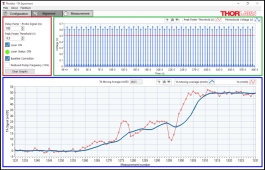
Click for Details
Figure 6.1 The signal acquisition tab in the software GUI. The red, green, and blue boxes indicate the settings panel, detector live signal feed, and TA live feed, respectively.
Software
Each kit includes a USB Stick with the free EDU-TRAS1 TA Experiment software package, which is used to set the acquisition parameters and record the measurements. A computer running Windows® 10 or higher is required, as well as a USB 2.0 port for connecting the DAQ card (included with the kit). This software features three tabs for signal acquisition, measurement, and advanced settings. Measurements can be saved as .csv files and measurement parameters are saved as a .xml file.
Signal Acquisition Tab
This tab, which is shown in Figure 6.1, is used to monitor the signal during setup alignment and also sets the parameters for a transient absorption (TA) measurement. It consists of three main areas: a settings panel, detector live signal feed, and the transient absorption live feed.
The settings panel, marked by the red box in Figure 6.1, is at the top-left of the GUI. This is where the delay time between the pump and probe pulses is set, as well as the threshold voltage above which a peak is recognized. The pump and probe lasers are also activated here, and a status readout is provided. Additional settings include baseline correction, which subtracts off the photodiode offset voltage to bring the baseline to 0 V, and reduced pump frequency, which reduces the laser power to an intensity safer for alignment.
The detector signal live feed, marked by the green box in Figure 6.1, shows a plot of the photodiode output voltage sampled by the DAQ card and updates every 40 ms. Single pulses are visible when the probe laser hits the detector. The trace marks the detector signal, the blue squares are the sampling points of the DAQ card, and the horizontal line indicates the value set as the peak threshold.
The transient absorption live feed, indicated by the blue box, is at the bottom of the signal acquisition tab. This graph shows the TA signal in red, where each data point is calculated from 40 pulse pairs. To account for the significant noise in the measured TA signal, a rolling average of the last 10 data points is also displayed as a blue line.
Measurement Tab
To generate a TA decay curve, the TA signal is recorded for gradually increasing time delays between the pump and probe laser pulses. The measurement tab, which is shown in Figure 6.2, is used to set the measurement parameters, and it consists of three main areas: a settings panel, an information panel, and a live graph.
The start and end delays of the measurement are set in the settings panel of the GUI, which is highlighted by the red box. The delay step widths are fixed at 10 ns, and for the measurements in this kit, a range from -400 ns to 5000 ns is recommended. Also set here is the number of average cycles, which is used to improve the signal-to-noise ratio of the measurement.
The information panel at the bottom-left of the GUI, marked by the blue box in Figure 6.2, contains information about the running experiment. Displayed are the laser status, the current delay time, and the current curve (of the average) being measured. There is also a notes box to add comments about the measurement, which will be saved to the .xml file.
To the right of the GUI is a live feed graph; see the green box in Figure 6.2. This displays the curves of the completed cycles and the average of the completed cycles. The curve of a measurement cycle only appears after the cycle is finished.
Settings Tab
The standard settings in this tab work for the recommended kit samples. Since changing these parameters can degrade performance, this tab is locked upon starting the software. In special cases where instructors want to modify the kit experiment, the settings can be unlocked and changed. Note that there is button to reset to the default values.
Thorlabs' Time-Resolved Absorption Spectroscopy Kit uses two Class 3B lasers, the NPL45B and NPL52C nanosecond pulsed lasers, which requires that all users be trained and follow all necessary safety protocols. This includes wearing the LG3 laser safety glasses shipped with the kit. More details about the laser classification system and Thorlabs laser safety products can be found here.
Laser Safety and Classification
Safe practices and proper usage of safety equipment should be taken into consideration when operating lasers. The eye is susceptible to injury, even from very low levels of laser light. Thorlabs offers a range of laser safety accessories that can be used to reduce the risk of accidents or injuries. Laser emission in the visible and near infrared spectral ranges has the greatest potential for retinal injury, as the cornea and lens are transparent to those wavelengths, and the lens can focus the laser energy onto the retina.
Safe Practices and Light Safety Accessories
- Laser safety eyewear must be worn whenever working with Class 3 or 4 lasers.
- Regardless of laser class, Thorlabs recommends the use of laser safety eyewear whenever working with laser beams with non-negligible powers, since metallic tools such as screwdrivers can accidentally redirect a beam.
- Laser goggles designed for specific wavelengths should be clearly available near laser setups to protect the wearer from unintentional laser reflections.
- Goggles are marked with the wavelength range over which protection is afforded and the minimum optical density within that range.
- Laser Safety Curtains and Laser Safety Fabric shield other parts of the lab from high energy lasers.
- Blackout Materials can prevent direct or reflected light from leaving the experimental setup area.
- Thorlabs' Enclosure Systems can be used to contain optical setups to isolate or minimize laser hazards.
- A fiber-pigtailed laser should always be turned off before connecting it to or disconnecting it from another fiber, especially when the laser is at power levels above 10 mW.
- All beams should be terminated at the edge of the table, and laboratory doors should be closed whenever a laser is in use.
- Do not place laser beams at eye level.
- Carry out experiments on an optical table such that all laser beams travel horizontally.
- Remove unnecessary reflective items such as reflective jewelry (e.g., rings, watches, etc.) while working near the beam path.
- Be aware that lenses and other optical devices may reflect a portion of the incident beam from the front or rear surface.
- Operate a laser at the minimum power necessary for any operation.
- If possible, reduce the output power of a laser during alignment procedures.
- Use beam shutters and filters to reduce the beam power.
- Post appropriate warning signs or labels near laser setups or rooms.
- Use a laser sign with a lightbox if operating Class 3R or 4 lasers (i.e., lasers requiring the use of a safety interlock).
- Do not use Laser Viewing Cards in place of a proper Beam Trap.
Laser Classification
Lasers are categorized into different classes according to their ability to cause eye and other damage. The International Electrotechnical Commission (IEC) is a global organization that prepares and publishes international standards for all electrical, electronic, and related technologies. The IEC document 60825-1 outlines the safety of laser products. A description of each class of laser is given below:
| Class | Description | Warning Label |
|---|---|---|
| 1 | This class of laser is safe under all conditions of normal use, including use with optical instruments for intrabeam viewing. Lasers in this class do not emit radiation at levels that may cause injury during normal operation, and therefore the maximum permissible exposure (MPE) cannot be exceeded. Class 1 lasers can also include enclosed, high-power lasers where exposure to the radiation is not possible without opening or shutting down the laser. |  |
| 1M | Class 1M lasers are safe except when used in conjunction with optical components such as telescopes and microscopes. Lasers belonging to this class emit large-diameter or divergent beams, and the MPE cannot normally be exceeded unless focusing or imaging optics are used to narrow the beam. However, if the beam is refocused, the hazard may be increased and the class may be changed accordingly. |  |
| 2 | Class 2 lasers, which are limited to 1 mW of visible continuous-wave radiation, are safe because the blink reflex will limit the exposure in the eye to 0.25 seconds. This category only applies to visible radiation (400 - 700 nm). |  |
| 2M | Because of the blink reflex, this class of laser is classified as safe as long as the beam is not viewed through optical instruments. This laser class also applies to larger-diameter or diverging laser beams. |  |
| 3R | Class 3R lasers produce visible and invisible light that is hazardous under direct and specular-reflection viewing conditions. Eye injuries may occur if you directly view the beam, especially when using optical instruments. Lasers in this class are considered safe as long as they are handled with restricted beam viewing. The MPE can be exceeded with this class of laser; however, this presents a low risk level to injury. Visible, continuous-wave lasers in this class are limited to 5 mW of output power. |  |
| 3B | Class 3B lasers are hazardous to the eye if exposed directly. Diffuse reflections are usually not harmful, but may be when using higher-power Class 3B lasers. Safe handling of devices in this class includes wearing protective eyewear where direct viewing of the laser beam may occur. Lasers of this class must be equipped with a key switch and a safety interlock; moreover, laser safety signs should be used, such that the laser cannot be used without the safety light turning on. Laser products with power output near the upper range of Class 3B may also cause skin burns. |  |
| 4 | This class of laser may cause damage to the skin, and also to the eye, even from the viewing of diffuse reflections. These hazards may also apply to indirect or non-specular reflections of the beam, even from apparently matte surfaces. Great care must be taken when handling these lasers. They also represent a fire risk, because they may ignite combustible material. Class 4 lasers must be equipped with a key switch and a safety interlock. |  |
| All class 2 lasers (and higher) must display, in addition to the corresponding sign above, this triangular warning sign. |  |
|
This kit grew out of a collaboration with Tiago Buckup from the Marcus Motzkus Group at Heidelberg University. Their motivation was to teach students about the pump-probe methodology. Since they found no teaching kit on ultra-fast time-resolved spectroscopy, they partnered with Thorlabs to use our nanosecond lasers. In particular, we thank Tiago Buckup for developing the prototype and finding ideal samples that allow nonhazardous experiments. The feedback from his students and his practical courses helped tremendously to improve the provided teaching material.
Do you have ideas for an experiment that you would like to see implemented in an educational kit? Contact us at techsupport@thorlabs.com; we'd love to hear from you.
| Posted Comments: | |
| No Comments Posted |

- Includes All Components to Build a Setup for Nanosecond Time-Resolved Absorption Spectroscopy
- Measures Transient Absorption Curves to Determine Population Decay Times and Reaction Rates
- Requires User-Supplied Sample Solutions
- EDU-TRASK Sample Kit with Prepared Solutions Sold Below
- Includes Software for Alignment and Data Acquisition
Thorlabs' EDU-TRAS1(/M) Time-Resolved Absorption Spectroscopy (TRAS) Educational Kit contains all of the optical and mechanical components, as well as the pulsed laser sources, needed to build a nanosecond TRAS setup. A full list of the included components can be found on the Kit Components tab. Software for controlling the acquisition parameters and carrying out measurements is provided on a USB stick and is also available for download; see the Software tab for more information. Metric and imperial versions of the TRAS kit are available.
This kit is intended to investigate the population dynamics of the well-studied molecule Zinc-Tetraphenylporphyrin (ZnTPP) and the subsequent charge transfer process to fullerene C70. Additional details on transient absorption and the contributing excitation processes can be found on the Kit Basics tab. The samples needed for the experiments outlined on the Experiments tab are not included. The EDU-TRASK sample kit, which includes pre-prepared sample solutions, is available for purchase below. Details on preparing the sample solutions from raw chemicals can be found on the Samples tab and in the kit manual.
Note: This kit uses two Class 3B lasers, the NPL45B and NPL52C nanosecond pulsed lasers, which requires that all users be trained and follow all necessary safety protocols. This includes wearing the LG3 laser safety glasses shipped with the kit. More details about the laser classification system and Thorlabs laser safety products can be found on the Laser Safety tab.

| Table G2.1 EDU-TRASKa Sample Kit | |||
|---|---|---|---|
| Sample Name | Volume | Concentration ZnTPP in BN | ZnTPP:C70 |
| BZ08 | 4 mL | 0.8 mmol/L | 1:0 |
| BZ04 | 4 mL | 0.4 mmol/L | 1:0 |
| BZ02 | 4 mL | 0.2 mmol/L | 1:0 |
| BZC01 | 4 mL | 0.4 mmol/L | 1:0.1 |
| BZC05 | 4 mL | 0.4 mmol/L | 1:0.5 |
| BZC1 | 4 mL | 0.4 mmol/L | 1:1 |
- Six 4 mL Pre-Mixed Samples (See Table G2.1)
- Three Zinc-Porphyrin (ZnTPP) in Benzonitrile (BN) Concentrations
- Three Ratios of ZnTPP to Fullerene C70
- Ten Disposable Pipettes with 1 mL Volume
- SDS Booklet
The EDU-TRASK Sample Kit is designed for customers who are not able to make their own ZnTPP samples for the EDU-TRAS1(/M) Time-Resolved Absorption Spectroscopy Educational Kit experiments; see the Samples tab for more information on sample preparation.
The attached MSDS, found by clicking the (![]() ) icon, is given in nine languages.
) icon, is given in nine languages.
 Products Home
Products Home







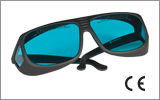
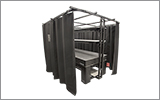
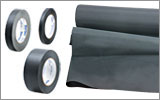
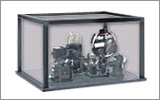
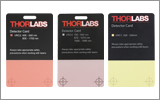
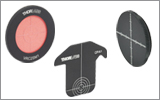
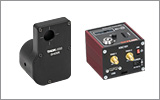
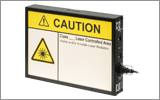
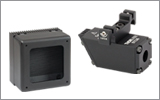
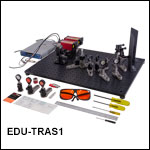
 Zoom
Zoom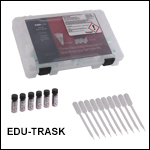
 Time-Resolved Absorption Spectroscopy Kit
Time-Resolved Absorption Spectroscopy Kit